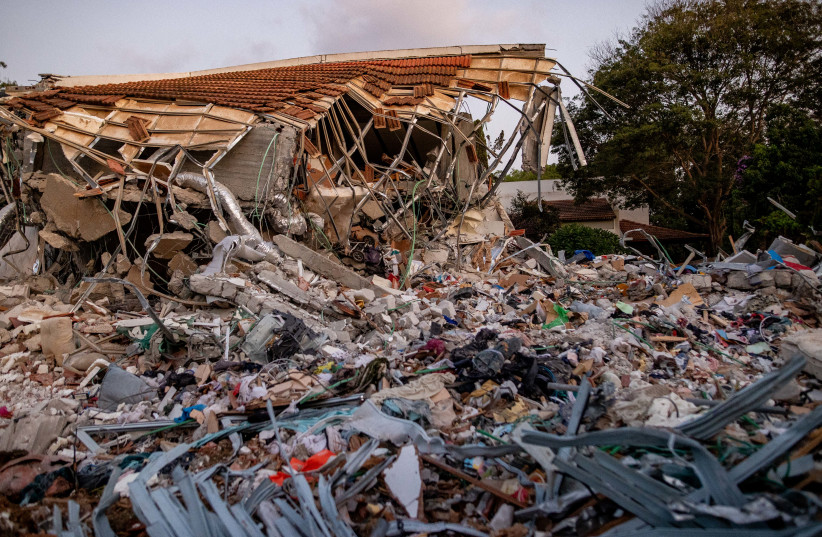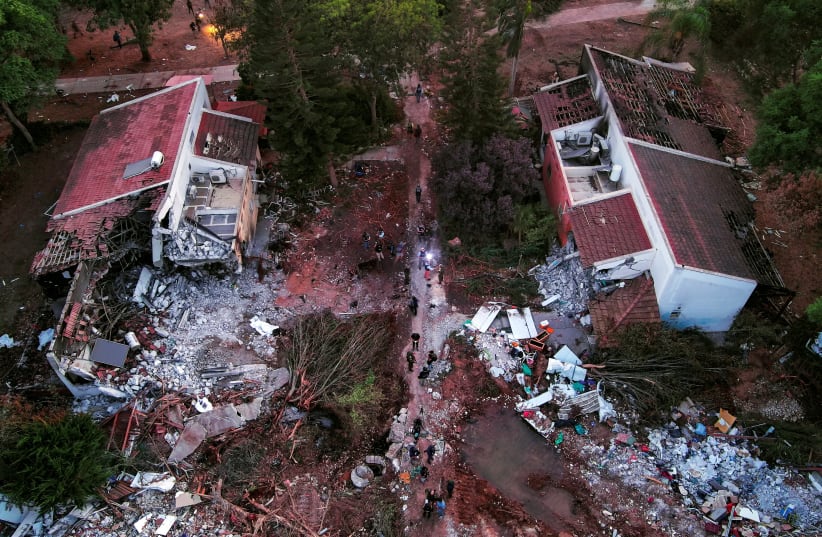It’s hardly begun. The war can last months or years, and guessing its course, length, and price would be futile. However, Israel’s postwar agenda can already be delineated, and it should include three tasks: Build, heal, and remember.
Building will obviously focus on the three cities and 17 rural communities that sustained the invaders’ attack. The overall damage has been preliminarily assessed by Treasury officials at NIS 3 billion. On the ground, this means hundreds of houses charred, farms scorched, factories looted, and gardens torched. All of these should be rebuilt, to the last garage, shack, and porch, at the taxpayers’ expense.
This is besides the human cost.
An estimated 1,000 of the invasion’s fatalities were residents of the western Negev, murdered either near or inside their homes.
In some cases – Beeri, Nahal Oz, and Nir Oz – the number of casualties and abductees is such that the entire community is shattered.


Reconstruction will thus have to be not only personal but also communal and regional. Of the western Negev’s 117,000 inhabitants, 13,000 have been evacuated from the rural communities, and that was before Sderot’s 35,000 residents were told to relocate as well.
The communal reconstruction’s aim should therefore be threefold: First, return as many victims as possible to their rebuilt homes, then reinforce their communities, and then double the region’s population – not only because this is a beautiful part of the country but also because doubling its population, schools, farms, businesses, and parks will serve as a reminder that the more our enemy spreads death, the more we will spread life.
It may all sound like a tall order, but it’s nothing Israel has not done before. Between 1953 and 1966, Israel built 21 new cities from scratch. This task will be smaller. However, none of this will materialize if postwar Israel does not launch a major healing process.
A major postwar healing process in the wake of Hamas's massacre
THE MASSACRE has left us feeling personally victimized, but not all our wounds were inflicted by the enemy. We arrived at this war wounded, and our prewar wounds were not the enemy’s doing but our own.
Did ordinary citizens inflict wounds on themselves? Of course they did, but our war on ourselves had leaders – politicians who knowingly, consciously, and repeatedly pitted us Israelis against each other.
It happened both rhetorically and programmatically. Rhetorically, politicians routinely bandied divisive statements that were factually unfounded and politically reckless, beginning with “some on the Left forgot what being Jewish means” (Benjamin Netanyahu, 1997).
Our postwar healing demands that our politicians radically change the way they talk with and about each other. They must learn to dialogue rather than shout, to debate rather than bicker, to listen rather than interrupt, and to talk about adversaries with dignity, humility, and respect. They should defy the riffraff’s impulse, not inflame it.
The same should go for the politicians’ programs.
When this war is over, leaders from across the political spectrum should convene and set a framework for constitutional dialogue, one that will transcend ordinary politics, search and cultivate the consensus, and find ways to gradually and harmoniously etch it in stone. If this mayhem does not convince them that a divided Israel is a vulnerable Israel, what will?
In the same spirit, our longtime political hegemon, Likud, should initiate and lead the healing of what it has historically treated as its enemy, and now looms as one of this war’s most bloodied victims: the kibbutz movement.
There were historical reasons for Likud’s hostility, but now that hostility must make way for a big rapprochement. Until his arrival last Saturday in the ruins of Kfar Aza and Be’eri, Netanyahu had never entered a kibbutz for a dialogue with its members. Even in Be’eri, he didn’t meet with them.
If there is any compassion in that man, he should now meet with the kibbutz movement’s leaders, salute their sacrifice, publicly recognize their pioneering efforts over a century, and ask them how he can help. It would do wonders for the healing process that the nation he leads now begs.
Netanyahu’s long-overdue embrace of the kibbutz movement does not have to wait until after the war; it can begin tonight. The same goes for postwar Israel’s cultural task.
THE WARSAW Ghetto was already crowded with deported Jews when one of them, historian Emanuel Ringelblum, had a vision: document what was being done to the Jews.
“Everything must be documented, without omitting one fact,” he said, so “when the time comes – and it will come – the world will read and learn what the murderers have done.” Ringelblum and a team he assembled thus collected thousands of testimonies, stuffed them into shoe boxes and milk containers, and buried them underground.
Ringelblum didn’t survive, but parts of his archive did, and indeed helped the commemorative cause he resolved to serve.
This month’s massacre demands such an effort. One such initiative has already been announced by Col. (res.) Yigal Carmon, who said his Middle East Media Research Institute will collect testimonies of what happened, where, when, and how. Other outfits will surely join.
Remembering is for us Jews both habit and command. The habit harks back centuries, to Nathan Hanover’s Yeven Mezulah (Abyss of Despair, Venice, 1653), which chronicled the Cossack massacres of 1648-9; and to the chronicles of the Crusaders’ massacres (collected in Abraham Meir Habermann’s Sefer Gzerot Ashkenaz ve-Sarefat, Jerusalem 1945). The command that guided them, and will guide us, harks back millennia, to “remember what Amalek did to you” (Deuteronomy 25:17).
Remember we shall – every executed child, every murdered adult, every raped woman, and every burnt house – even while we rebuild our towns, nurse our wounds, and heal our nation. We shall remember them now, and our descendants shall remember them forever.
www.MiddleIsrael.net
The writer, a Hartman Institute fellow, is the author of the bestselling Mitzad Ha’ivelet Ha’yehudi (The Jewish March of Folly, Yediot Sefarim, 2019), a revisionist history of the Jewish people’s political leadership.
